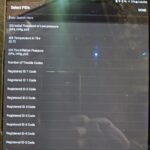The dreaded check engine light – it’s a signal no car owner wants to see illuminated on their dashboard. In the past, this warning often meant an expensive and time-consuming trip to the mechanic just to diagnose the problem. However, with the advent of Obdii Engine Code Readers, understanding and addressing car troubles has become significantly more accessible. This guide will delve into the world of OBDII engine code readers, explaining what they are, why you need one, and how they can empower you to take control of your vehicle’s health.
What is an OBDII Engine Code Reader?
OBDII stands for On-Board Diagnostics II, a standardized system implemented in most cars manufactured after 1996. This system monitors various aspects of your vehicle’s performance and emissions, and when it detects an issue, it triggers the check engine light and stores a diagnostic trouble code (DTC). An OBDII engine code reader, also known as an OBD2 scanner or scan tool, is a handheld device that connects to your car’s OBDII port – typically located under the dashboard – and retrieves these DTCs.
These codes are essentially alphanumeric identifiers that pinpoint the area of the problem. For example, a code starting with “P0” generally indicates a powertrain issue. The code reader displays these codes, allowing you to understand what system is reporting a problem, be it the engine, transmission, emissions system, or others. While the code itself might not tell you the exact failed component, it provides a crucial starting point for diagnosis.
Why You Need an OBDII Code Reader
Owning an OBDII engine code reader offers numerous benefits for car owners, from the everyday driver to the seasoned automotive enthusiast:
- Early Problem Detection: An OBDII reader allows you to identify minor issues before they escalate into major, costly repairs. Addressing a small sensor malfunction early can prevent damage to more expensive components down the line.
- Cost Savings: Diagnosing the check engine light at home can save you money on diagnostic fees at a mechanic. Knowing the code beforehand can also help you get a more accurate estimate for repairs, preventing overcharging.
- DIY Car Repair Empowerment: For those who enjoy DIY car maintenance, an OBDII reader is an indispensable tool. It empowers you to understand the problem, research potential solutions, and even perform simple repairs yourself.
- Informed Mechanic Visits: Even if you prefer professional repairs, knowing the OBDII code before visiting a mechanic puts you in a position of knowledge. You can have a more informed conversation, understand the proposed repairs better, and ensure transparency.
- Vehicle Health Monitoring: Beyond just the check engine light, some advanced OBDII readers can monitor real-time data from your vehicle, such as engine temperature, RPM, and sensor readings. This allows for proactive monitoring of your car’s overall health.
Key Features to Look For in an OBDII Reader
The market offers a wide range of OBDII engine code readers, from basic, affordable models to advanced, feature-rich scanners. When choosing a reader, consider these features:
- Code Reading and Clearing: At a minimum, the reader should be able to read and clear diagnostic trouble codes. Clearing codes after a repair can turn off the check engine light.
- Code Definitions: A good reader will provide not just the code, but also a description of what the code means, saving you the need to look it up separately.
- Live Data Stream: More advanced readers offer live data streaming, displaying real-time sensor readings, which is invaluable for diagnosing intermittent issues or monitoring performance.
- Compatibility: Ensure the reader is compatible with your vehicle’s make and model, although most OBDII readers are universally compatible with OBDII-compliant vehicles.
- Ease of Use: Look for a reader with an intuitive interface, clear display, and easy navigation.
- Additional Features: Some readers offer extra features like freeze frame data (showing vehicle data when the code was triggered), O2 sensor testing, and even ABS/SRS diagnostics in higher-end models.
How to Use an OBDII Engine Code Reader
Using an OBDII engine code reader is generally straightforward:
- Locate the OBDII Port: Find the OBDII port in your car, usually under the dashboard on the driver’s side.
- Plug in the Reader: With the ignition off, plug the OBDII reader into the port.
- Turn Ignition to “ON”: Turn the ignition key to the “ON” position (do not start the engine).
- Read Codes: Follow the reader’s instructions to retrieve diagnostic trouble codes.
- Interpret Codes: Use the reader’s built-in definitions or consult online resources to understand the meaning of the codes.
- Clear Codes (Optional): After diagnosing and addressing the issue, you can use the reader to clear the codes and turn off the check engine light. Note: Clearing codes without fixing the problem will only result in the light coming back on.
Choosing the Right OBDII Reader for You
The best OBDII engine code reader for you depends on your needs and budget.
- Basic Readers: For simple code reading and clearing, a basic, affordable reader will suffice. These are ideal for occasional check engine light issues and general DIY car owners.
- Mid-Range Readers: If you want live data streaming and code definitions, a mid-range reader offers a good balance of features and price. Suitable for more involved DIYers and car enthusiasts.
- Professional Scanners: For advanced diagnostics, ABS/SRS capabilities, and comprehensive features, professional-grade scanners are available. These are typically used by mechanics and serious automotive technicians.
No matter your level of automotive expertise, an OBDII engine code reader is a valuable tool to have in your arsenal. It empowers you to understand your vehicle better, save money on repairs, and take proactive steps to maintain your car’s health, ensuring a smoother and more informed car ownership experience.

